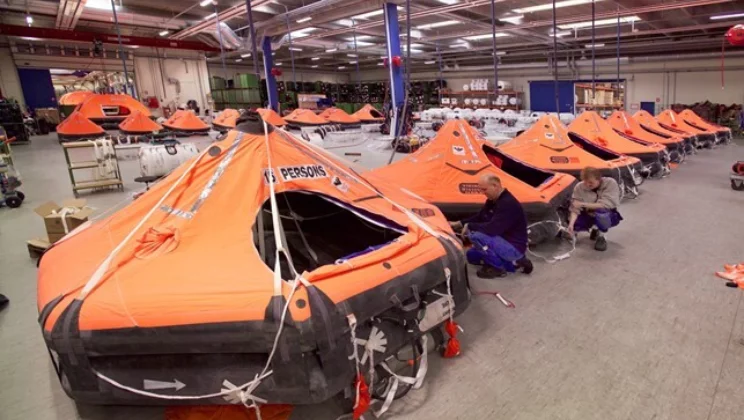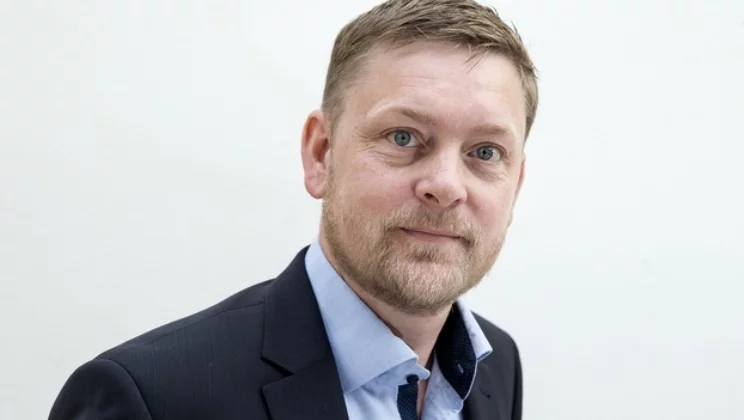Every year, 500 students from Aarhus University’s Herning campus go on placements to work for companies in central and western Jutland where they assist with everything from drawing up business plans to solving concrete tasks. For VIKING Life Savings based at Esbjerg, one particular placement was such a great success that it resulted in a permanent job for the student and the company gained control of its logistics. Now, the university is looking for more businesses interested in hosting a task force or perhaps taking on a student as part of a placement scheme.
How can we set up a new, green business plan?
What strategies and digital tools can help us support our sustainable production?
How can we as a company optimise our inventories?
These are just some of the challenges companies at Port Esbjerg are dealing with – and students from Aarhus University may be able to help developing appropriate solutions.
Camilla Møller, who is Global Customer Logistics Director at VIKING Life-Saving Equipment A/S, was faced with the optimisation challenge in 2021.
To find a solution, Viking decided to take on a placement student for the logistics and planning department. The ideal profile was a student studying operations management or engineering, so they could get more of a math-savvy approach when tackling assignments. In came a student who applied an analytical approach to estimate future consumption based on last year’s data with an added growth factor. That enabled her to point to a better way to build inventories.
“We were truly impressed by her skills and qualifications. She was a big help, and after the placement, we hired her as a student assistant,” explains Møller.
The placement scheme is part of a programme at Aarhus University headed by Professor Anders Frederiksen of the Department of Business Development and Technology. He sees an obvious potential for cooperating more closely with businesses in Esbjerg.
“Many of the challenges businesses are facing today are actually quite similar. The green transition requires people, brains and brawn – and sometimes a new approach,” says Frederiksen.

A student from Aarhus University point to a better way to build inventories at VIKING Life-Saving Equipment A/S.
Close ties to business and industry
The Department of Business Development and Technology deals with every kind of issue that businesses face. They can assist with everything from business plans to technology challenges, and the student profiles span from engineering to IT and business.
“We place 500 students in 250 businesses every year, and we would love to connect with even more Esbjerg companies,” says Frederiksen.
“Our students are capable of addressing an issue, analysing it and contributing to business development. They can be taken on in one of two ways: some are offered general placement, while others are brought onboard to complete specific cases at the companies,” explains Frederiksen.
In his experience, particularly the SMEs – small and medium-sized enterprises – are the ones looking for technology innovation, and many of the students are able to make a big difference for them. The vast majority of the companies offering student placements are SMEs.

Professor Anders Frederiksen of the Department of Business Development and Technology sees an obvious potential for cooperating more closely with businesses in Esbjerg.
Free sounding-board service about technology challenges
To some extent, students are matched with businesses when they take part in the TBMI challenge, which is one of the key modules for civil engineering students studying technology-based business development. The module is run by the Department of Business Development and Technology with Mirko Presser in charge. It is a way of ensuring that the students get a good experience while working at a company. During the TBMI (Technological Business Model Innovation) module, the students learn to build or improve on a company’s business model by applying technology.
The programme culminates in the so-called TBMI challenge, where businesses across central and western Jutland take in students to solve concrete issues.
They are given many different types of challenges, such as identifying digital technologies that can help produce more efficient route planning for deliveries and pick-ups, for example. Ideas or input for an even better customer experience. How an industrial 3D print infrastructure can help improve a stakeholder’s product development processes. How to turn textile waste into soft and comfortable garden furniture. Or how to create more climate and environmentally friendly concrete foundations for the wind turbine industry.
The students conclude their assignments by submitting a report describing how the company can benefit from new business opportunities and technologies. Modules run from February to June.
“Companies are generally very pleased with the programme. They get a free assessment of concrete issues, something they would otherwise have to pay a lot of money for. The people providing the solutions are obviously students, but companies are given new perspectives, thoughts and different approaches to their businesses,” says Presser.
An assignment may involve anything from a business case to more concrete technical challenges, so the students will typically do everything they can to understand the challenge in context; they look at production lines, make on-location visits, and more.
“The feedback we’re getting is that most companies go on to implement the solutions they’re provided with,” says Presser.
Students generally work at companies in groups of four or five. Right now, we have teams at nine companies that all have technology challenges related to the green transition.
Green transition makes on-site visits more relevant
Jan Laursen, a student advisor at the Department of Business Development and Technology at the Herning campus of Aarhus University, arranged for the student to take up a placement at Viking where she assisted the company in getting the inventory logistics under control. He is responsible for students studying business engineering and arranges their placements with companies. He explains that the placement scheme compels the university to stay relevant to business and industry.
“When businesses change, we must change with them. Viking is a good example of how both parties can play to each other’s strengths. It’s good for both sides,” says Laursen.
Professor Anders Frederiksen explains that there are many reasons why the university forges a connection to business and industry. It is good for student learning, it helps to boost their self-confidence and gives them a chance to feel that they can make a difference.
At the same time, companies benefit from students asking questions, because it may help them move to a next level. Quite often, there’s a connection between ongoing research and the issues faced by individual companies.
“We need to be relevant for young people as well as for businesses, and the green transition has emphasised that need for both parties,” says Frederiksen.
He regards Port Esbjerg and its business environment as particularly interesting.
“Esbjerg has something special to offer because there are so many businesses dealing with green transition. That makes for greater mutual benefit,” says Frederiksen.
In the case of Viking, the student did not leave at the end of the placement, as she was hired as a student assistant. Moreover, the company has offered her a job when she graduates.
“We’re so pleased with our placement student that we’ve offered her a job and she’ll start working for us when she completes her studies in January 2023,” says Camilla Møller of Viking
Want to know who to contact if you’re interested in offering a student placement?
Click this link.
send an email to john.hansen@au.dk or call +45 87166916
Click here to learn more about the TBMI.
Get more information about the many types of projects available here.
Go to overview

